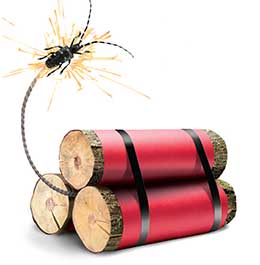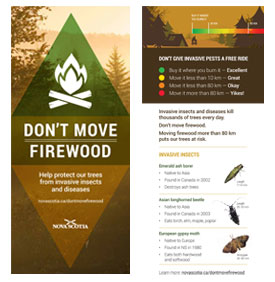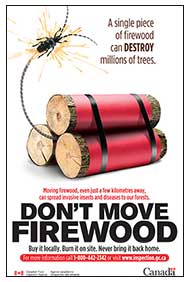Don't Move Firewood
Planning to bring your own firewood? Information you should know
 It might seem innocent enough, but moving firewood has the potential to destroy thousands of trees. Moving firewood is a common way for insects and diseases to spread into our forests and urban trees. Pests can live in it, on it, or under the bark of firewood. Moving firewood gives these hitchhikers a free ride!
It might seem innocent enough, but moving firewood has the potential to destroy thousands of trees. Moving firewood is a common way for insects and diseases to spread into our forests and urban trees. Pests can live in it, on it, or under the bark of firewood. Moving firewood gives these hitchhikers a free ride!
Help protect our trees by preventing the spread of invasive insects and diseases:
- Don’t bring firewood
- Buy it where you burn it
- Leave un-used firewood
Forest pests, insects and diseases, can be living on or in firewood. On their own these insects and diseases don’t move very far but when we move firewood we are helping spread these pests further and possibly into new areas. New infestations of forest pests can have a negative impact on the forests (i.e. kills trees), property values, urban streets and parks, animal habitat, economy (e.g. trade) and the environment (e.g. air and water quality.)
The Canadian Food Inspection Agency (CFIA) regulates the movement of firewood from pest-regulated areas throughout Canada. There are CFIA plant protection policies in place for quarantined pests, regulated to prevent further spread. Be aware of restrictions that may be in place; moving firewood from places that are regulated can be a violation of the Plant Protection Act.
Firewood from any other country cannot be imported into Canada with the exception of some parts of the United States with strict requirements.
For more information about CFIA regulations, contact your local CFIA office or visit the website ttp://www.inspection.gc.ca/plants/forestry/firewood/eng/1330963478693/1330963579986
Any insect or disease that lives on or in firewood can be spread by the movement of firewood. The emerald ash borer, for example, has killed millions of ash trees in Canada since it first arrived from Asia in 2002. On its own, it does not move very far but has travelled further distances by (i.e. human assisted) movement on firewood.
In certain areas or provinces, there may be ministerial orders that restrict or prohibit the movement of firewood from regulated areas in order to reduce the spread of invasive forest pests such as the emerald ash borer. Consult the Canadian Food Inspection Agency for information on regulated areas and transporting firewood.
http://www.inspection.gc.ca/plants/forestry/firewood/eng/1330963478693/1330963579986
Canadian Food Inspection Agency has issued regulations to prevent further spread of the following quarantined pests:
- Brown spruce longhorn beetle (NS)
- Dutch elm disease (NS, PEI, NB, QC, ON, MB,SK and USA)
- European larch canker (NS, NB, PEI and Maine)
- European gypsy moth (NS, NB, PEI, QC, ON and various states)
- Asian long-horned beetle (ON)
- Emerald ash borer (ON, QC and various States)
- Pine shoot beetle (ON, QC and various States)
When we say local firewood, we are referring to the closest convenient source of wood that you can find.
When purchasing wood as a heat source for your home, you should purchase wood from the closest convenient wood vendor and leave your firewood at home. Do not take firewood from your home with you camping or to the cottage.
For camping, buy it where you burn it. Most campgrounds have firewood for sale.
There are four main groups of insects that can be found in wood:
- Bark beetles – burrow between the bark (e.g. spruce beetle)
- Ambrosia beetles – bore through the bark and into the sapwood and/or heartwood (e.g. elm beetle – the carriers of the Dutch elm disease)
- Woodborers – found either between the wood and bark, or in the heartwood or sapwood (e.g. the longhorn beetles (Genus: Cerambyicidae) such as the brown spruce longhorn beetle, sawyer beetles, etc.)
- Wood wasps (aka horntails) – bore into the sapwood and heartwood of living trees
Some examples of tree diseases that can be found on firewood are:
- Dutch elm disease and European larch canker
No, it is still not okay to move your firewood even though you don’t see any signs of a forest pest. There may be a disease or insect on or within the firewood that is not visible to the eye. For example, there could be a tiny insect egg under a piece of bark or fungus spores on the firewood. It is best to buy it where you burn it, then there’s no risk of spreading forest pests.
Even though you burned all the firewood there is still a risk that you may have spread a forest pest. For example, maybe an insect egg or larva was on a piece of bark that fell off the firewood on to the ground or an adult emerged from the wood in transit. It’s still best not to move firewood. Buy it where you burn it!
It’s best to leave your firewood at home to avoid the risk of spreading an invasive forest pest. It is not a good idea to take firewood with you. Pest infestations can take years to be recognized. By the time the tree looks sick you could have spread the infestation to all your favorite campsites! Don’t take a chance. Get your firewood at your destination. Buy the wood as close to where you burn it as possible.
Packaged firewood comes in a lot of forms and it is important to know the difference between kiln dried and heat treated firewood.
Kiln drying removes the moisture content from the wood but does not sterilize or rid the wood of all pests. There is still a risk of moving some invasive forest pests with kiln dried firewood. Woodborers such as the emerald ash borer can survive on firewood that has been kiln dried.
Heat treatment ensures the internal temperature of the wood reaches a critical temperature for a set duration in order to kill all life stages of pests. It is this process that is used to eradicate any living organisms in wood.
For more information on the “Don’t Move Firewood” campaign and invasive forest pests, please visit these websites:
- Canadian Food Inspection Agency — http://www.inspection.gc.ca/plants/forestry/firewood/eng/1330963478693/1330963579986
- Natural Resources Canada — http://www.nrcan.gc.ca/forests/insects-diseases/13361
- Natural Resources Canada — Forest Invasive Alien Species of Canada http://www.exoticpests.gc.ca/
- Nature Conservancy - Don’t Move Firewood — http://www.dontmovefirewood.org/
- United States Department of Agriculture, Animal and Plant Health Inspection Services — https://www.aphis.usda.gov/aphis/ourfocus/planthealth/plant-pest-and-disease-programs
- Emerald ash borer — http://www.emeraldashborer.info/firewood.cfm#sthash.vqagy6jW.CEbzYel1.dpbs

